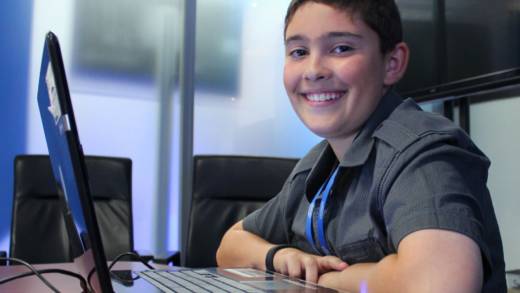Common Core and NGSS have many teachers working to develop their own curriculum and the days of using a textbook teacher’s edition or student workbooks are gone. Although we are thankful for that, we know that if we are to compete with the myriad distractions our students are exposed to on a regular basis, we have to create lessons that speak the language of digital natives.s. This is where appsmashing comes in.
What is appsmashing?
Appsmashing, as defined by Greg Kulowiec (@gregkulowiec on Twitter), is the process of using multiple apps in conjunction with one another to complete a final task or project. This may sound kind of scary, but the reality is that you’ve been doing it for years. Remember that first time you created a PowerPoint and tried to embed a video in it? Or when you asked your students to create a website and insert images in it? Those are early forms of appsmashing.
Why appsmash?
Even with all the technology tools now available, there is rarely one that can do everything I need/want. Appsmashing demands creative thinking and helps turn not having the “perfect app” into a positive. It has allowed me to take a topic as far as it can be taken, providing opportunities to create engaging learning products. Most importantly, Appsmashing is fun.
How do I appsmash to teach and differentiate?
In my middle school classroom, I am fortunate enough to have 1:1 devices. This means that I can create as many digital lessons as I need in as many levels as I wish. There are several sites that allow me to fuse content together, providing my students several avenues to access the curriculum. Here are some of my favorites.
- Thinglink: Developed as a way to annotate digital images, Thinglink can be used to link content and give instructions. I have used it to create differentiated choice boards, provide access to content and even to give instructions, as in the case of my Source to Mouth project
- Blendspace and LessonPaths: Both sites allow you to curate resources from the Web and even upload your own. These are particularly useful for differentiation, since you can create playlists that look and feel virtually the same, but that are at different reading or mastery levels.
- Symbaloo Lesson Plans: Symbaloo has been around for a long time as a bookmarking site. Recently it launched a lesson plan site that takes bookmarking to the next level, allowing you to create lesson boards with content, questions, etc. You can pretty much use it to embed anything, as I did in this Digital Citizenship lesson.
- Wizer.me: Intended to be used as digital worksheets, the site allows you to embed content from around the Web and use its different features to have students respond. In this Potential and Kinetic Energy example, you can see how I used it to host Blendspace and LessonPaths so students could access and respond in one place.
Appsmashing and Project Based Learning
Appsmashing can also be used as a way to introduce and guide students through a PBL experience. I use appsmashing to create project pages to communicate expectations, as well as to host all the materials the students will need, including the rubrics. My favorite appsmash tools to host PBL are:
- WIX: This is a Web page–creation platform that allows me to add anything, anywhere on the sites I create, and making it easy to include any of the interactive tools I mentioned earlier. For example, in our TrashTalk project, I used it to create the project website, adding video and Thinglinks with resources and instructions.
- Hstry: Developed as a way to create interactive timelines, it can easily be used to create appsmashed projects. I use it whenever I feel students need to access a PBL run in a linear fashion, as was the case of the We Are What We Do project.
- Tackk: More linear than WIX, but less restrictive than Hstry, you may think that Tackk was developed with appsmashing in mind as it allows you to embed practically anything and easily share with your students. In this Motion and Forces Tacck example, I’ve taken appsmashing to the extreme, pairing it with Thinglink, Wizerme, Edpuzzle, Lessonpaths, Blendspace and Youtube, and then had students respond to a Wix page using Hstry. I know, it’s probably too much, but I wanted to show you just how far you can take things.
Appsmashing with students
The idea of asking students to appsmash came to me during a recent run of my Endangered Species project. As it often happens, as soon as I finished answering questions about the project and started walking around, I noticed that all students had immediately started creating slide decks. As I pondered the thought of sitting through several text heavy “presentations” being read by my students, my heart sank.
